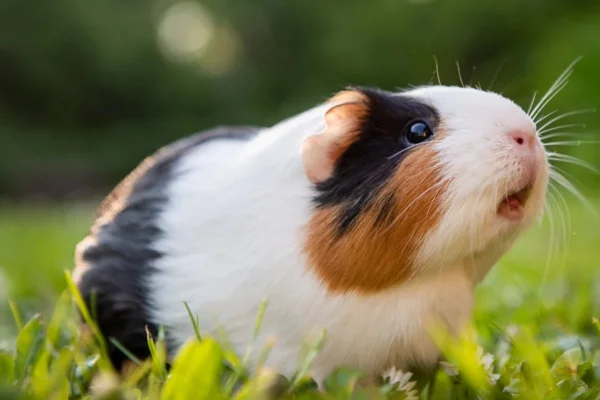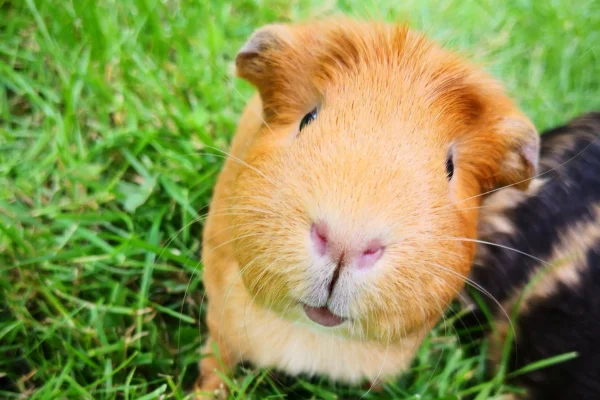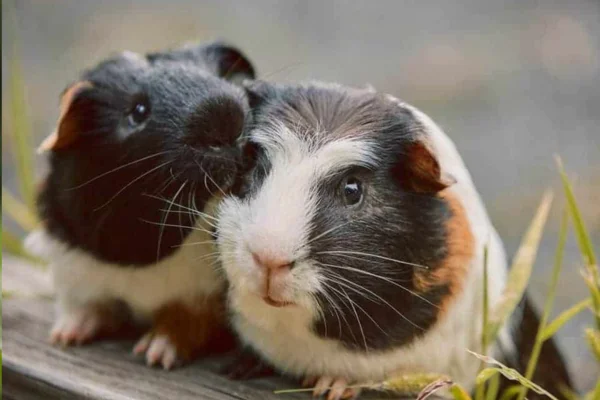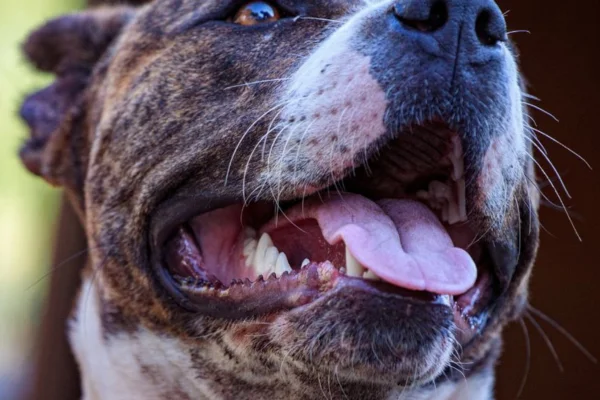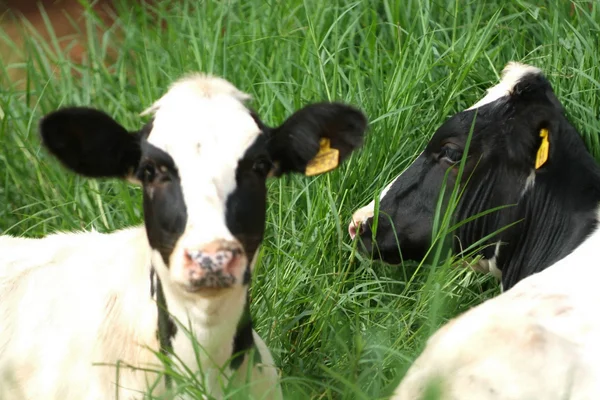The Fascinating World of Guinea Pigs: Characteristics, Habitat, and Behavior
Introduction
Guinea pigs, scientifically known as Cavia porcellus, are charming small rodents that have won hearts worldwide. Originating from South America, these adorable animals have a long history of coexistence with humans, being valued for their unique characteristics and sociable behavior.
In this article, we will delve deeply into the fascinating world of guinea pigs, exploring their physical characteristics, natural habitat, behavior, diet, reproduction, and the importance of veterinary care.
With a detailed and authoritative look, we will present comprehensive information that will help understand these incredible companions better.
Contents
Detailed Physical Characteristics of Guinea Pigs
Guinea pigs, scientifically known as Cavia porcellus, are robust and compact small rodents that captivate with their simplicity and grace. The absence of a visible tail, combined with a dense and varied coat, significantly contributes to their unmistakable charm. Let’s explore in detail the main physical characteristics of these charming animals, from their body structures to their dimensions and weight.
Body Structure
Head: The head of guinea pigs is proportionately large in relation to their body, a characteristic that gives them a peculiar and attractive appearance. Their eyes are large and expressive, providing excellent peripheral vision that helps them detect dangers and explore their surroundings. The ears are small, rounded, and highly sensitive to high-pitched sounds, allowing guinea pigs to quickly perceive any unexpected noise or potential threat.
Coat: The coat of guinea pigs is one of their most distinctive and varied features. It can present different textures, from silky and smooth to long and wavy fur, adding significant aesthetic diversity to the species. The coat colors can vary widely, including shades of white, black, brown, orange, and a combination of these. Some guinea pigs may have spotted or striped patterns, making each individual unique in appearance. The density and quality of the coat not only serve an aesthetic purpose but also provide a layer of protection against the elements.
Dentition: The dentition of guinea pigs consists of incisors that grow continuously throughout their lives. This characteristic is common among rodents and is vital for the survival of the species. The constant need to gnaw on fibrous materials is essential to prevent excessive tooth growth, which can lead to serious health problems if not properly managed. Gnawing activity also strengthens the jaw muscles and prevents uneven tooth wear.
Paws: The paws of guinea pigs are short and sturdy, adapted to support their compact and robust bodies. Each front paw has four toes, while the hind paws have three toes. The sharp claws are used for digging and manipulating food, as well as for self-defense in dangerous situations. Additionally, the paws provide agility and stability, allowing guinea pigs to move quickly when necessary.
Dimensions and Weight
Guinea pigs have an average size that ranges between 20 to 25 centimeters in length, making them suitable as pets in various types of homes. The weight of guinea pigs can fluctuate between 700 to 1,200 grams, depending on the sex and lineage. Generally, females are slightly smaller and lighter than males, although these variations are relatively small. These dimensions allow guinea pigs to be easily carried, handled safely, and comfortably kept in domestic environments.
Sense of Smell and Hearing
Guinea pigs have a highly developed sense of smell, which is one of their primary senses. They heavily rely on this sense to navigate their environment, find food, and recognize other group members. The olfactory system of guinea pigs is adapted to detect a wide range of odors, allowing them to differentiate between fresh and spoiled foods, as well as identify potential predators or dangers in the environment.
In addition to their sense of smell, guinea pigs’ hearing is also extremely acute. They can detect high-frequency sounds that are beyond the range of human hearing. This ability is particularly useful in nature, where it can alert them to the presence of predators or changes in the environment. In captivity, the sensitivity of guinea pigs’ hearing can make them susceptible to stress caused by loud or unexpected noises, so it is important to provide a calm and safe environment for them.
Vision and Taste
While the vision of guinea pigs is not as developed as their sense of smell and hearing, they have good peripheral and motion perception. Their large, laterally positioned eyes provide a wide field of vision, allowing them to quickly detect movements around them. However, their ability to perceive details and colors is limited compared to their other senses.
The taste of guinea pigs is well-developed and plays an important role in food selection. They are quite selective and prefer fresh and nutritious foods. Bitter taste is usually avoided, as it may indicate toxic foods in nature. This selective feeding is an evolutionary adaptation that helps ensure guinea pigs consume an adequate and balanced diet.
Natural Habitat
The ancestors of guinea pigs inhabited the Andean regions of South America, where they lived in social groups in grasslands and dense vegetation areas. These environments offered an abundance of food and protection against predators, essential for their survival.
Adaptations to Habitat:
Burrows: They used abandoned burrows made by other animals or dug their own for shelter. Foraging: Their natural diet included a variety of vegetation available in the Andean plains, such as grasses, leaves, and fruits.
Behavior and Socialization
Guinea pigs are known for their sociable and communicative behavior. They thrive better in groups, as social interaction is fundamental to their well-being.
Vocalizations and Communication:
- Squeaking: Used to express excitement or call for attention.
- Purring: Indicative of comfort and contentment.
- Grunts: Often used as warning signals or to establish dominance.
Social Hierarchies:
In groups, they establish clear hierarchies, with a dominant individual who leads and organizes the group. Regular interaction helps prevent aggressive behaviors and mental health problems.
Daily Activities:
Exploration: They enjoy exploring their environment, using their sense of smell and whisker touch to investigate new objects. Gnawing: Gnawing is a constant activity, necessary to keep their incisors at the proper length and prevent dental problems.
Diet
Proper nutrition is vital for the health of guinea pigs. Their diet should be rich in fiber and vitamin C, as they cannot synthesize this essential vitamin.
Diet Components:
- Hay: The staple of their diet, essential for healthy digestion and natural tooth wear.
- Fresh Vegetables: Include dark leafy greens such as kale and spinach, as well as bell peppers, carrots, and cucumbers.
- Commercial Pellets: Specifically formulated for guinea pigs, ensuring they receive all necessary nutrients.
- Fruits: Offered in moderation, such as apples and pears, due to their high sugar content.
- Fresh Water: Should always be available and changed daily.
Reproduction
Guinea pigs have a high reproductive rate, which requires special attention from breeders and caretakers to avoid overpopulation.
Reproductive Cycle:
- Estrus: Females enter estrus approximately every 15 to 20 days.
- Gestation: Pregnancy lasts an average of 59 to 72 days, resulting in litters that can vary from 1 to 6 pups.
–
Development of the Young:
- Development: The young are born developed, with fur, open eyes, and the ability to move and eat solids within hours after birth.
- Maternal Care: The mother is extremely protective, nursing the young for about 3 weeks until they are fully weaned.
Reproduction Considerations:
- Planning: Proper planning is essential to avoid overpopulation and ensure all young receive appropriate care.
- Health: Monitoring the health of females during pregnancy and after delivery is crucial to prevent complications.
Health and Veterinary Care:
Keeping guinea pigs healthy involves regular veterinary care and attention to common signs of illnesses. Below are some main health concerns and best care practices:
Dental Problems:
- Overgrown Teeth: Can cause pain, difficulty eating, and infections. Providing adequate materials to gnaw on is essential.
- Malocclusion: A condition where teeth do not align properly, requiring veterinary intervention.
Respiratory Diseases:
- Rhinitis: Inflammation of the nasal passages, often caused by bacterial or viral infections.
- Pneumonia: A lung infection that can be fatal if untreated. Symptoms include difficulty breathing and lethargy.
Vitamin C Deficiency:
- Scurvy: Causes symptoms like lethargy, loss of appetite, bleeding, and joint problems. Vitamin C supplementation in the diet is essential.
External Parasites:
- Fleas and Lice: Can cause intense itching, hair loss, and secondary infections. Preventive treatments are recommended.
General Care Tips:
- Habitat: Should be spacious and secure, with areas for hiding and activities. Proper bedding, such as recycled paper, prevents foot problems.
- Hygiene: Regular cleaning of the habitat to avoid the accumulation of feces and urine, preventing diseases.
- Socialization: Social and environmental stimulation is important to keep guinea pigs active and happy.
Health Monitoring:
- Regular Check-ups: Periodic visits to the vet to monitor general health and prevent problems.
- Daily Observation: Being attentive to changes in behavior, appetite, or physical appearance that may indicate health issues.
Conclusion
Guinea pigs are extraordinary pets, whose popularity is due to their friendly nature and relatively simple care requirements. However, to ensure their well-being, it is crucial to understand their specific needs, provide an adequate environment, a balanced diet, and regular veterinary care.
With proper management, guinea pigs can live from 5 to 7 years, providing joy and companionship throughout this time.
Preserving the health and well-being of guinea pigs not only improves the quality of life of these small companions but also strengthens the bond between the animals and their owners, promoting harmonious and rewarding living together. Understanding and meeting the needs of guinea pigs is a commitment that results in a deeply satisfying and enriching relationship.
–

